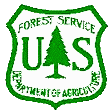
Chapter 1
Ecological Subregions of the United
States
| Back |  |  Contents |  | Forward |
 | Chapter 1 |
|
Arctic Tundra
One Section has been delineated in this Province:124A--Coastal Plain.
The area of this Section, located in northern Alaska, is about 19,100 mi2 (49,500 km2).
Section 124A--Coastal Plain
Geomorphology. A relatively smooth plain that gradually ascends from the Arctic Ocean to the adjacent Brooks Range foothills. The area is mantled with Quaternary deposits of alluvial, glacial, and aeolian origin. Permafrost-related terrain features mark local surfaces (e.g., pingos, ice-wedge polygons, frost boils). Small sand dunes irregularly occur along the coast. Essentially, the area is a gently rolling to level, treeless plain with many lakes and rivers. Elevation is less than 660 ft (200 m).
Lithology and Stratigraphy. Occurs entirely within the North Slope subterrane consisting of basin deposits of Permian to lower Mesozoic age; marine and continental deposits of Tertiary age and older. The origin of the deep sediments is thought to be continental shelf deposits from the floor of the Beaufort Sea.
Soil Taxa. The dominant soils are Aquepts, primarily Histic Pergelic Cryaquepts and Pergelic Cryaquepts.
Potential Natural Vegetation. Wet tundra communities dominated by sedges, rushes, mosses, lichens, and willows.
Fauna. Many species of waterfowl nest in the numerous lakes and ponds of the Arctic coastal plain. Brant and common eider are prevalent in this area. Seabirds such as the pomarine jaeger, glaucous gull, and black guillemot are characteristic breeders. The semipalmated sandpiper is a common breeder in this section. The breeding range of the rare curlew sandpiper is limited to the tundra adjacent to the coast. The musk ox was extirpated in the 1850's and 1860's; reintroduction efforts began in 1969. Characteristic mammalian predators include Arctic foxes throughout the Section and polar bears in the vicinity of the coast. Pink and chum salmon are present in this Section but in limited numbers; this represents the northern limit of their range.
Climate. Average annual precipitation ranges from 4 to 6 in (100 to 150 mm). Average annual temperature ranges from 8 to 14 oF (-13 to -10 oC). In general, the growing season is from about June 15 to August 1. Frosts may occur in any month.
Surface Water Characteristics. Lakes, ponds, and streams make up more than 20 percent of the area. Streams originate in the highlands to the south; most of the smaller ones dry up or freeze completely during the winter. All soils are underlain by permafrost and are usually saturated throughout the summer. Wetlands occupy over 82 percent of the area.
Disturbance Regimes. Disturbance from wildfire is low.
Land Use. Most development is related to oil and gas extraction. Agriculture is severely limited by climate.
Cultural Ecology. Villages are primarily occupied by Inupiaq Eskimos.
Compiled by Alaska Region.
Back
ContentsForward